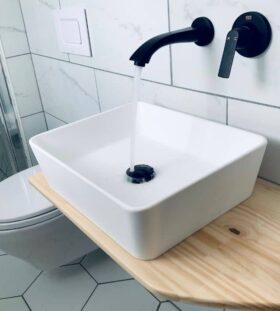Top tips for installing a floating sink as a beginner
If you’re a beginner at installing a floating sink, several tips will help you get started. These steps will teach you how to install the drain, cut your countertop precisely, and add a shelf riser.
Table of Contents
Step 1: Make a precision cut in the countertop
Getting your sink to fit properly requires precision. That’s why making a precision cut on the countertop is a good idea before installing a floating sink. It will ensure that your sink is a smooth fit. Plus, it will help prevent leaks from the cabinet to the counter.
To make a precision cut, you can use a large carpenter’s square to measure the edge of your countertop. Then, use a jigsaw to cut out the shape of your sink. You can also use a round file to round off the corners. If cutting a square sink, you’ll need four strips of three-quarter-inch particle board for each corner. For a round sink, you’ll also need a template.
The next step is applying a contact adhesive layer over the entire perimeter of your sink. Then, place your sink into the opening and gently press the sides of the sink to the top of the countertop. After a few minutes, apply another layer of adhesive around the outside of your sink to secure it in place.
Lastly, sand the sink’s edges with a belt sander to ensure that your sink is smooth. It’s a good idea to use 80- or 60-micron paper. In addition, consider sanding the counter after the sink is in place. The product from https://wetstyle.com/product/floating-sink-bracket/ will help prevent scratches.
Step 2: Place the sink on the dresser or vanity
If you’re trying to install a vanity and sink in your bathroom, you must ensure they fit together properly. You also must ensure that you have the correct plumbing set-up, such as a faucet and drain. You can follow a few simple steps to ensure your vanity and sink installation is completed smoothly.
First, you need to find the studs in the wall. You will need to locate the studs using a stud finder. Once you’ve located them, you can mark them on the wall. Then, you can use a jigsaw or hole saw to cut a hole in the vanity or dresser.
After determining the position, you can start putting the furniture pieces together. Use wood glue to bond the pieces together. Alternatively, you can install wood blocking between the studs. It allows you to raise the vanity. Lastly, you’ll need to secure the vanity to the wall with drywall screws.
After completing the above steps, you’re ready to install the vessel sink. Depending on the type of sink, you’ll need a power drill, a countersink bit, a hole saw, a pencil, and a measuring tape. Also, having another person with you is a good idea to help you finish the job. Completing this project can take a while, so be encouraged if you need help or the right tools.
Step 3: Install the drain
It is essential to consider the location of the sink drain. The drainage route should be at least meters from walls or shrubs. It will allow water to flow through and filter out any debris. Landscaping around the drain will prevent it from getting clogged with dirt and other objects. Landscaping can also be used to provide a decorative touch to the area. To get started, measure the area and mark it with a pencil.
Next, install the tailpiece for the drain. You will need a countersink drill bit, and a hole saw. For extra support, you can use scrap wood underneath the countertop. After you have threaded the tailpiece onto the drain body, attach the slip joint nut. Tighten it using an adjustable wrench. Once the nut is secured, you can install the trap arm. Make sure that it is sloping downward toward the drain outlet.
If you are installing a single basin sink, you may not need a tee fitting on the tailpiece. However, you should ensure you do not run the drawer backs into the drain when closing them. A basket strainer should be installed on the remaining sink basin. Also, be sure to use a rubber washer on the drain body.
Finally, you will need to connect the drainage pipe. Installing a tee fitting can be difficult, and you should call a plumber. The sink should be connected to the drain, and any shutoff valves should be installed under the sink. Before the sink is installed, the base should be sealed with silicone. Allow the seal to set for about 30 minutes.
Whether installing a floating sink or a traditional kitchen sink, you’ll need to ensure that you don’t run any drawer backs into the drain pipe. Using a rubber washer can help prevent this problem.
Stuti Singhal is an avid reader and a creative writer. In her personal space she has been into weaving beautiful poems as well. .She is active in the professional field of content writing for last 5 years. Currently she is working as a content writer in association with a reputed digital marketing agency in New Delhi.
 Tagged:
Top tips for installing a floating sink as a beginner
Tagged:
Top tips for installing a floating sink as a beginner
